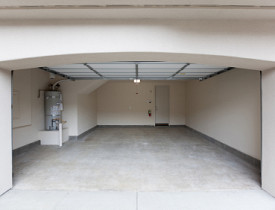Garage Door Sensors

I remember working with my dad on little projects around the house when I was growing up. One project we never got around to was installing an electric garage door opener.
Back then, about half the homes in my neighborhood had automatic door openers. My dad said we didn't need one because he had 3 boys that could do the job. We were the ones to get wet if we came home in the rain, not him; he also said it was good exercise.
Well, times change; back then we had 3 channels to choose from on TV, and we had to get off the couch to change them. Today, I would be hard-pressed to find a garage that does not have an automatic opener...or a TV without a remote. Those early garage openers were pretty primitive, and I often heard stories about people getting dents on the trunk or roof of their cars from the door coming down at the wrong time.
Thank the Lawyers
Today's garage openers are much safer. In addition to garage door sensors that stop and reverse the door if something crosses the threshold, most also have sensors that can reverse the door if it hits an obstruction. These improvements have resulted in much safer homes for countless families.
Alignment is Critical
The main garage door sensor that most people have trouble with is the sensor that monitors the threshold. These are typically light-based sensors - older ones used a simple light bulb, newer ones use infrared beams. With a smaller, single-width garage, this alignment is not so difficult. However, larger, double-sized doors require more precision. If your sensor is not working properly, it could be merely out of alignment. Loosen the mounting bolts on the garage door sensor and check its aim; often, an LED will light on the receiver side to show that signal is being received. An extra set of eyes can be very useful here if working in bright sunlight.
Another helpful tool is a long piece of string that can be stretched from garage door sensor to sensor. This can help with height adjustments. Once your sensors are realigned and working properly, tighten the mounting bolts. Loose mounting bolts on garage door sensors are a frequent occurrence, the result of normal vibrations during use. It's a good ideal to check these often.
Dirty Optics
The second problem most people have with garage door sensors is plain old dirt. Dust and grime can obstruct the lenses of the garage door sensor enough to prevent it operating properly. As part of your periodic checkup looking for loose bolts and such, a simple lens cleaning can keep things running smoothly. A little rubbing alcohol and some cotton swabs will make short work of this job.
Overhead Sensors
Another garage door sensor that may cause problems is the limit switch that tells the opener the door is closed: These are often located up at the drive motor. As the door spring weakens after years of service, the switch may need an adjustment. Since many models differ in how this is set up, consult your owners' manual for specifics on your model.
It has been quite some time since I had to open a garage door manually. My dad, like most people, has an opener on his garage now. After all, he is well into his 70s and all of his boys have long since moved out. He also has a remote for his TV, which gets a lot more than 3 channels. He would have to agree with me when I say, "(Some) progress is good."
Read up on garage door maintenance tips and adjustments that might be necessary. Proper care is critical to ensure your door operates safely.
If you don't have the time or inclination to maintain your garage door sensors yourself, find a professional to do the work for you.
Updated August 29, 2018.
Looking for a Pro? Call us (866) 441-6648

Garage door Average Costs
Garage Door Pros Experiences

Garage Door Opener Replacement As Part Of A Major Home Remodel

Garage Door Reinforcement Was A Fast And Effective Solution



